Organisational Behaviour Report: M&S, Leadership and Motivation
VerifiedAdded on 2022/11/25
|18
|5903
|364
Report
AI Summary
This report provides a comprehensive analysis of organisational behaviour, focusing on Marks and Spencer as a case study. It begins by examining how organisational culture, politics, and power influence individual and team behaviour and performance, referencing models like Charles Handy and Hofstede. The report then evaluates content and process theories of motivation, including intrinsic and extrinsic motivation, and how motivational techniques can enable the effective achievement of goals. Furthermore, the report explains the factors that contribute to effective teams versus ineffective teams. Finally, it applies concepts and theories of organisational behaviour within Marks and Spencer, offering practical insights into its application and strategic implications. The report concludes with a summary of the key findings and implications for organizational success.
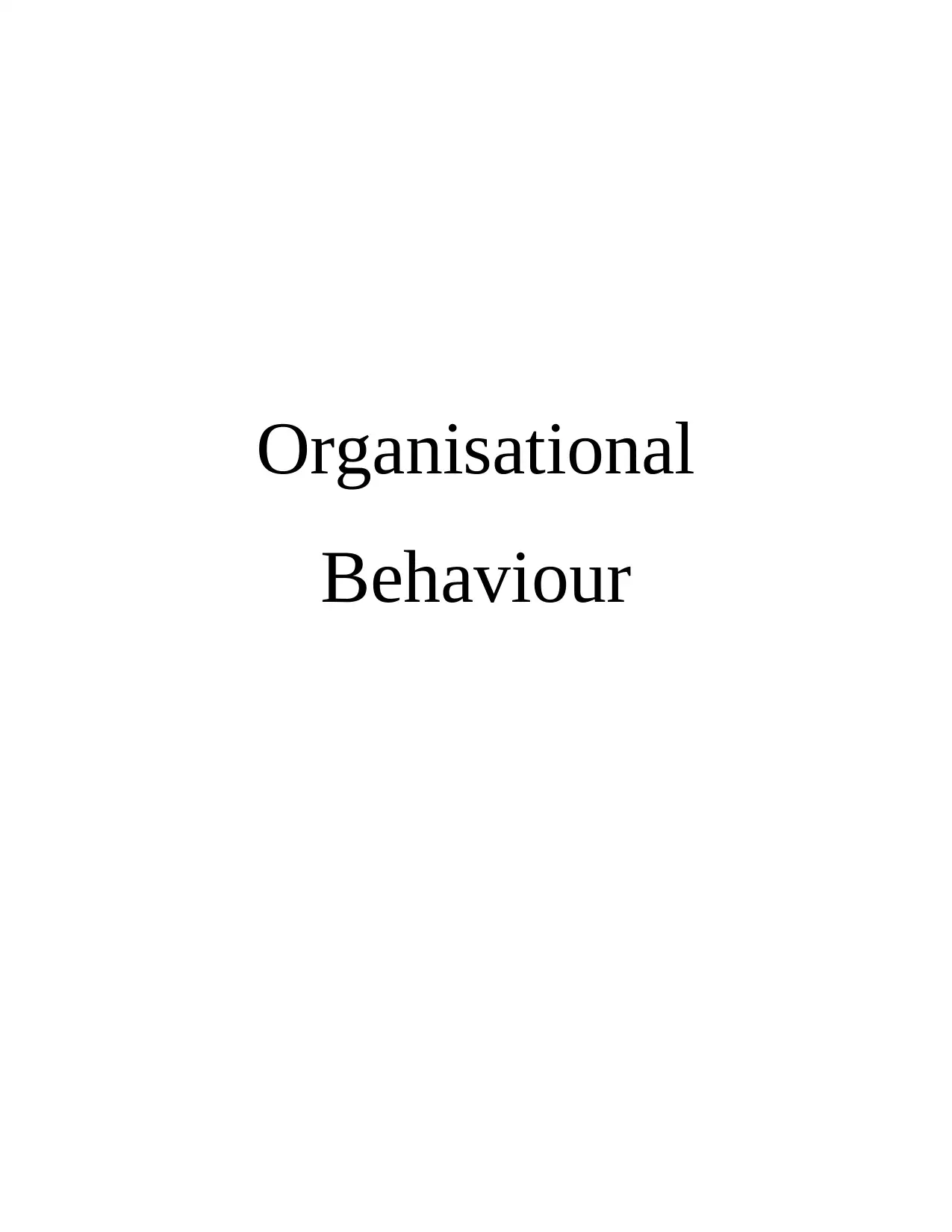
Organisational
Behaviour
Behaviour
Paraphrase This Document
Need a fresh take? Get an instant paraphrase of this document with our AI Paraphraser
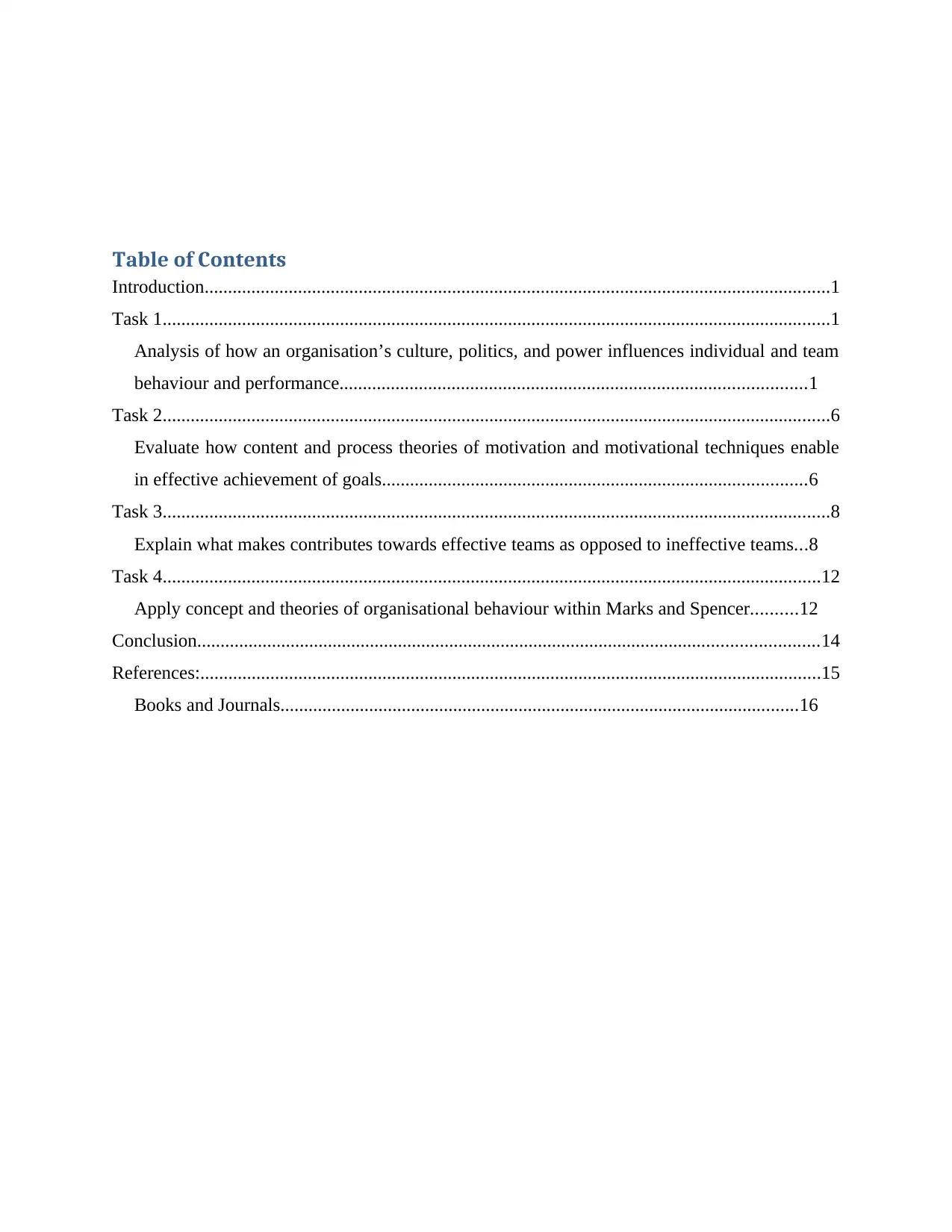
Table of Contents
Introduction......................................................................................................................................1
Task 1...............................................................................................................................................1
Analysis of how an organisation’s culture, politics, and power influences individual and team
behaviour and performance....................................................................................................1
Task 2...............................................................................................................................................6
Evaluate how content and process theories of motivation and motivational techniques enable
in effective achievement of goals...........................................................................................6
Task 3...............................................................................................................................................8
Explain what makes contributes towards effective teams as opposed to ineffective teams...8
Task 4.............................................................................................................................................12
Apply concept and theories of organisational behaviour within Marks and Spencer..........12
Conclusion.....................................................................................................................................14
References:.....................................................................................................................................15
Books and Journals...............................................................................................................16
Introduction......................................................................................................................................1
Task 1...............................................................................................................................................1
Analysis of how an organisation’s culture, politics, and power influences individual and team
behaviour and performance....................................................................................................1
Task 2...............................................................................................................................................6
Evaluate how content and process theories of motivation and motivational techniques enable
in effective achievement of goals...........................................................................................6
Task 3...............................................................................................................................................8
Explain what makes contributes towards effective teams as opposed to ineffective teams...8
Task 4.............................................................................................................................................12
Apply concept and theories of organisational behaviour within Marks and Spencer..........12
Conclusion.....................................................................................................................................14
References:.....................................................................................................................................15
Books and Journals...............................................................................................................16
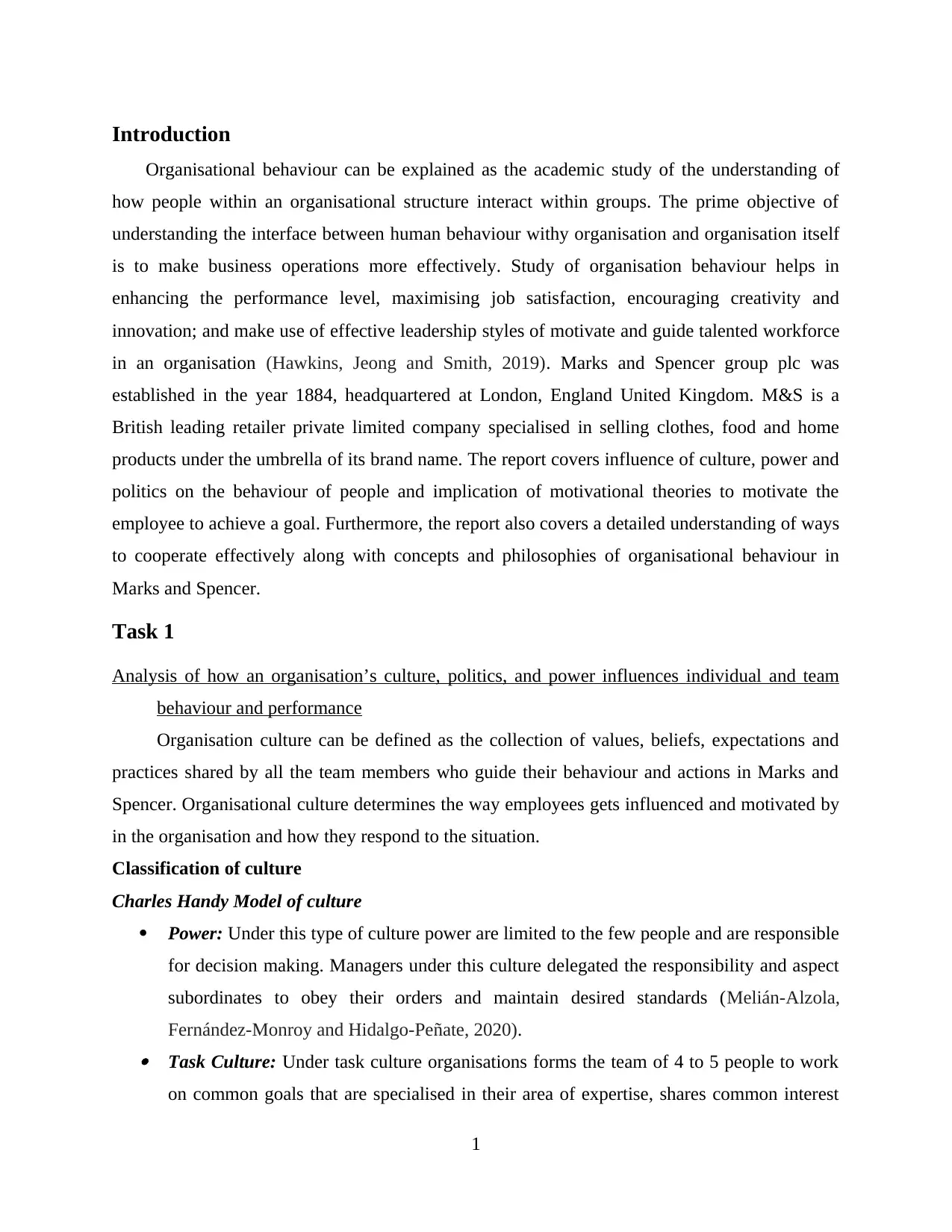
Introduction
Organisational behaviour can be explained as the academic study of the understanding of
how people within an organisational structure interact within groups. The prime objective of
understanding the interface between human behaviour withy organisation and organisation itself
is to make business operations more effectively. Study of organisation behaviour helps in
enhancing the performance level, maximising job satisfaction, encouraging creativity and
innovation; and make use of effective leadership styles of motivate and guide talented workforce
in an organisation (Hawkins, Jeong and Smith, 2019). Marks and Spencer group plc was
established in the year 1884, headquartered at London, England United Kingdom. M&S is a
British leading retailer private limited company specialised in selling clothes, food and home
products under the umbrella of its brand name. The report covers influence of culture, power and
politics on the behaviour of people and implication of motivational theories to motivate the
employee to achieve a goal. Furthermore, the report also covers a detailed understanding of ways
to cooperate effectively along with concepts and philosophies of organisational behaviour in
Marks and Spencer.
Task 1
Analysis of how an organisation’s culture, politics, and power influences individual and team
behaviour and performance
Organisation culture can be defined as the collection of values, beliefs, expectations and
practices shared by all the team members who guide their behaviour and actions in Marks and
Spencer. Organisational culture determines the way employees gets influenced and motivated by
in the organisation and how they respond to the situation.
Classification of culture
Charles Handy Model of culture
Power: Under this type of culture power are limited to the few people and are responsible
for decision making. Managers under this culture delegated the responsibility and aspect
subordinates to obey their orders and maintain desired standards (Melián-Alzola,
Fernández-Monroy and Hidalgo-Peñate, 2020). Task Culture: Under task culture organisations forms the team of 4 to 5 people to work
on common goals that are specialised in their area of expertise, shares common interest
1
Organisational behaviour can be explained as the academic study of the understanding of
how people within an organisational structure interact within groups. The prime objective of
understanding the interface between human behaviour withy organisation and organisation itself
is to make business operations more effectively. Study of organisation behaviour helps in
enhancing the performance level, maximising job satisfaction, encouraging creativity and
innovation; and make use of effective leadership styles of motivate and guide talented workforce
in an organisation (Hawkins, Jeong and Smith, 2019). Marks and Spencer group plc was
established in the year 1884, headquartered at London, England United Kingdom. M&S is a
British leading retailer private limited company specialised in selling clothes, food and home
products under the umbrella of its brand name. The report covers influence of culture, power and
politics on the behaviour of people and implication of motivational theories to motivate the
employee to achieve a goal. Furthermore, the report also covers a detailed understanding of ways
to cooperate effectively along with concepts and philosophies of organisational behaviour in
Marks and Spencer.
Task 1
Analysis of how an organisation’s culture, politics, and power influences individual and team
behaviour and performance
Organisation culture can be defined as the collection of values, beliefs, expectations and
practices shared by all the team members who guide their behaviour and actions in Marks and
Spencer. Organisational culture determines the way employees gets influenced and motivated by
in the organisation and how they respond to the situation.
Classification of culture
Charles Handy Model of culture
Power: Under this type of culture power are limited to the few people and are responsible
for decision making. Managers under this culture delegated the responsibility and aspect
subordinates to obey their orders and maintain desired standards (Melián-Alzola,
Fernández-Monroy and Hidalgo-Peñate, 2020). Task Culture: Under task culture organisations forms the team of 4 to 5 people to work
on common goals that are specialised in their area of expertise, shares common interest
1
⊘ This is a preview!⊘
Do you want full access?
Subscribe today to unlock all pages.

Trusted by 1+ million students worldwide
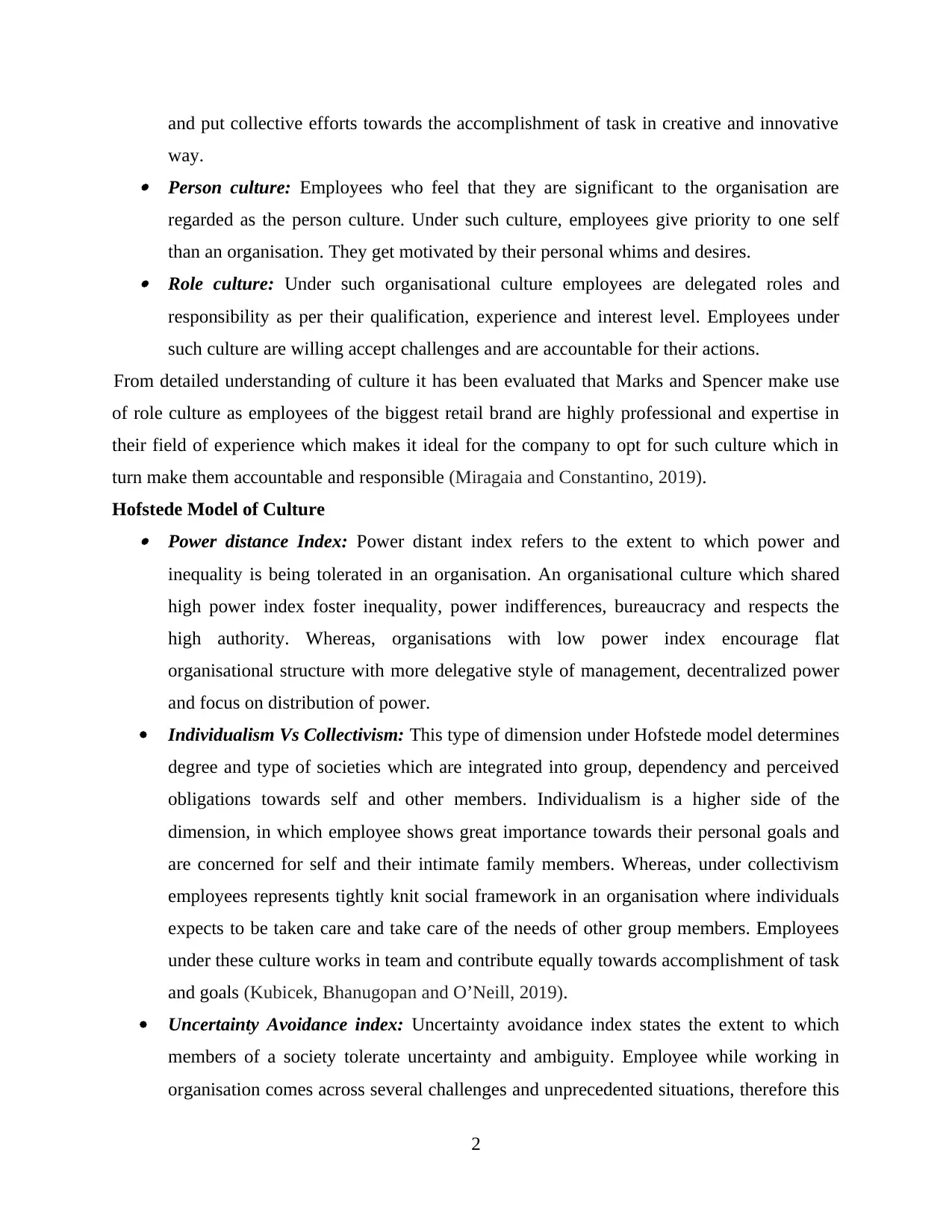
and put collective efforts towards the accomplishment of task in creative and innovative
way. Person culture: Employees who feel that they are significant to the organisation are
regarded as the person culture. Under such culture, employees give priority to one self
than an organisation. They get motivated by their personal whims and desires. Role culture: Under such organisational culture employees are delegated roles and
responsibility as per their qualification, experience and interest level. Employees under
such culture are willing accept challenges and are accountable for their actions.
From detailed understanding of culture it has been evaluated that Marks and Spencer make use
of role culture as employees of the biggest retail brand are highly professional and expertise in
their field of experience which makes it ideal for the company to opt for such culture which in
turn make them accountable and responsible (Miragaia and Constantino, 2019).
Hofstede Model of Culture Power distance Index: Power distant index refers to the extent to which power and
inequality is being tolerated in an organisation. An organisational culture which shared
high power index foster inequality, power indifferences, bureaucracy and respects the
high authority. Whereas, organisations with low power index encourage flat
organisational structure with more delegative style of management, decentralized power
and focus on distribution of power.
Individualism Vs Collectivism: This type of dimension under Hofstede model determines
degree and type of societies which are integrated into group, dependency and perceived
obligations towards self and other members. Individualism is a higher side of the
dimension, in which employee shows great importance towards their personal goals and
are concerned for self and their intimate family members. Whereas, under collectivism
employees represents tightly knit social framework in an organisation where individuals
expects to be taken care and take care of the needs of other group members. Employees
under these culture works in team and contribute equally towards accomplishment of task
and goals (Kubicek, Bhanugopan and O’Neill, 2019).
Uncertainty Avoidance index: Uncertainty avoidance index states the extent to which
members of a society tolerate uncertainty and ambiguity. Employee while working in
organisation comes across several challenges and unprecedented situations, therefore this
2
way. Person culture: Employees who feel that they are significant to the organisation are
regarded as the person culture. Under such culture, employees give priority to one self
than an organisation. They get motivated by their personal whims and desires. Role culture: Under such organisational culture employees are delegated roles and
responsibility as per their qualification, experience and interest level. Employees under
such culture are willing accept challenges and are accountable for their actions.
From detailed understanding of culture it has been evaluated that Marks and Spencer make use
of role culture as employees of the biggest retail brand are highly professional and expertise in
their field of experience which makes it ideal for the company to opt for such culture which in
turn make them accountable and responsible (Miragaia and Constantino, 2019).
Hofstede Model of Culture Power distance Index: Power distant index refers to the extent to which power and
inequality is being tolerated in an organisation. An organisational culture which shared
high power index foster inequality, power indifferences, bureaucracy and respects the
high authority. Whereas, organisations with low power index encourage flat
organisational structure with more delegative style of management, decentralized power
and focus on distribution of power.
Individualism Vs Collectivism: This type of dimension under Hofstede model determines
degree and type of societies which are integrated into group, dependency and perceived
obligations towards self and other members. Individualism is a higher side of the
dimension, in which employee shows great importance towards their personal goals and
are concerned for self and their intimate family members. Whereas, under collectivism
employees represents tightly knit social framework in an organisation where individuals
expects to be taken care and take care of the needs of other group members. Employees
under these culture works in team and contribute equally towards accomplishment of task
and goals (Kubicek, Bhanugopan and O’Neill, 2019).
Uncertainty Avoidance index: Uncertainty avoidance index states the extent to which
members of a society tolerate uncertainty and ambiguity. Employee while working in
organisation comes across several challenges and unprecedented situations, therefore this
2
Paraphrase This Document
Need a fresh take? Get an instant paraphrase of this document with our AI Paraphraser
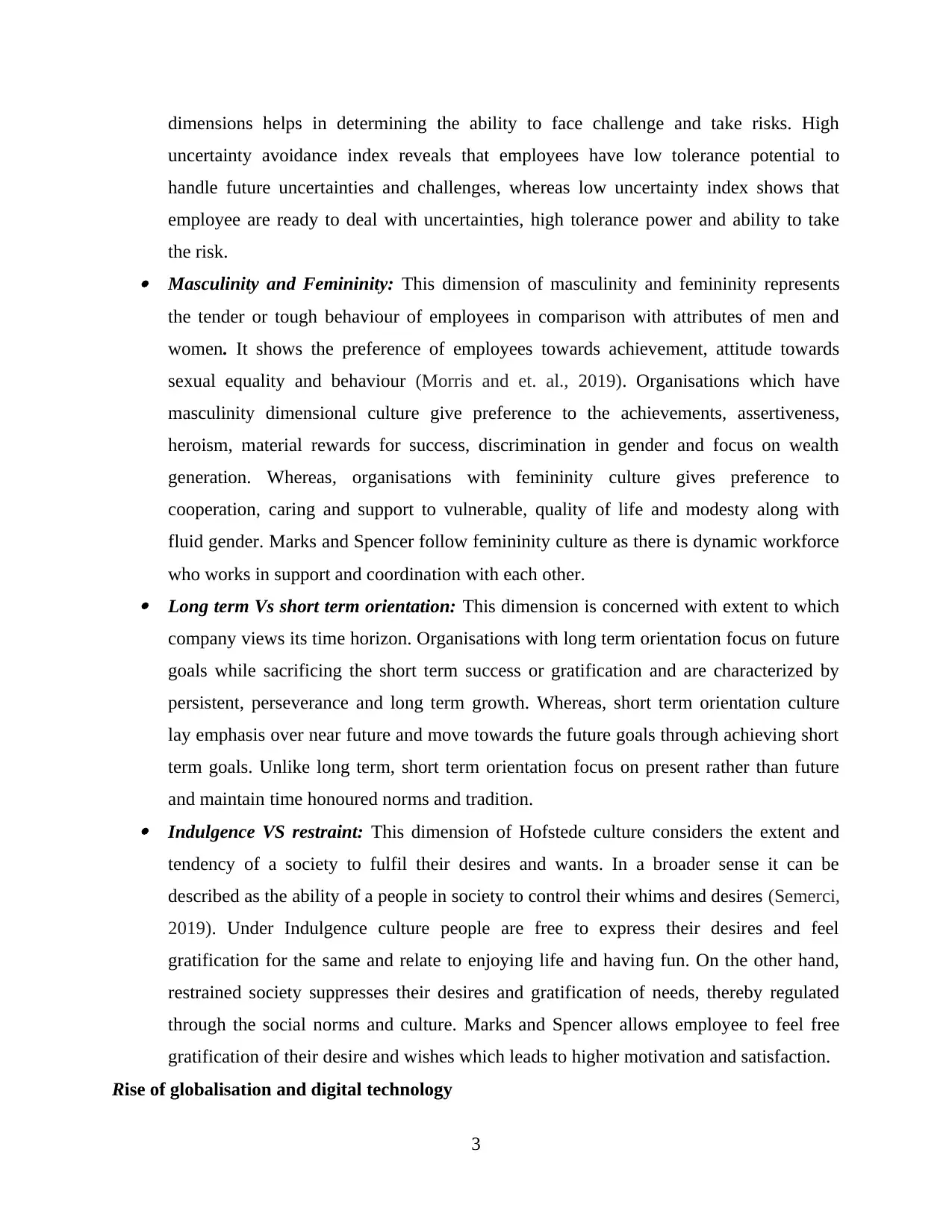
dimensions helps in determining the ability to face challenge and take risks. High
uncertainty avoidance index reveals that employees have low tolerance potential to
handle future uncertainties and challenges, whereas low uncertainty index shows that
employee are ready to deal with uncertainties, high tolerance power and ability to take
the risk. Masculinity and Femininity: This dimension of masculinity and femininity represents
the tender or tough behaviour of employees in comparison with attributes of men and
women. It shows the preference of employees towards achievement, attitude towards
sexual equality and behaviour (Morris and et. al., 2019). Organisations which have
masculinity dimensional culture give preference to the achievements, assertiveness,
heroism, material rewards for success, discrimination in gender and focus on wealth
generation. Whereas, organisations with femininity culture gives preference to
cooperation, caring and support to vulnerable, quality of life and modesty along with
fluid gender. Marks and Spencer follow femininity culture as there is dynamic workforce
who works in support and coordination with each other. Long term Vs short term orientation: This dimension is concerned with extent to which
company views its time horizon. Organisations with long term orientation focus on future
goals while sacrificing the short term success or gratification and are characterized by
persistent, perseverance and long term growth. Whereas, short term orientation culture
lay emphasis over near future and move towards the future goals through achieving short
term goals. Unlike long term, short term orientation focus on present rather than future
and maintain time honoured norms and tradition. Indulgence VS restraint: This dimension of Hofstede culture considers the extent and
tendency of a society to fulfil their desires and wants. In a broader sense it can be
described as the ability of a people in society to control their whims and desires (Semerci,
2019). Under Indulgence culture people are free to express their desires and feel
gratification for the same and relate to enjoying life and having fun. On the other hand,
restrained society suppresses their desires and gratification of needs, thereby regulated
through the social norms and culture. Marks and Spencer allows employee to feel free
gratification of their desire and wishes which leads to higher motivation and satisfaction.
Rise of globalisation and digital technology
3
uncertainty avoidance index reveals that employees have low tolerance potential to
handle future uncertainties and challenges, whereas low uncertainty index shows that
employee are ready to deal with uncertainties, high tolerance power and ability to take
the risk. Masculinity and Femininity: This dimension of masculinity and femininity represents
the tender or tough behaviour of employees in comparison with attributes of men and
women. It shows the preference of employees towards achievement, attitude towards
sexual equality and behaviour (Morris and et. al., 2019). Organisations which have
masculinity dimensional culture give preference to the achievements, assertiveness,
heroism, material rewards for success, discrimination in gender and focus on wealth
generation. Whereas, organisations with femininity culture gives preference to
cooperation, caring and support to vulnerable, quality of life and modesty along with
fluid gender. Marks and Spencer follow femininity culture as there is dynamic workforce
who works in support and coordination with each other. Long term Vs short term orientation: This dimension is concerned with extent to which
company views its time horizon. Organisations with long term orientation focus on future
goals while sacrificing the short term success or gratification and are characterized by
persistent, perseverance and long term growth. Whereas, short term orientation culture
lay emphasis over near future and move towards the future goals through achieving short
term goals. Unlike long term, short term orientation focus on present rather than future
and maintain time honoured norms and tradition. Indulgence VS restraint: This dimension of Hofstede culture considers the extent and
tendency of a society to fulfil their desires and wants. In a broader sense it can be
described as the ability of a people in society to control their whims and desires (Semerci,
2019). Under Indulgence culture people are free to express their desires and feel
gratification for the same and relate to enjoying life and having fun. On the other hand,
restrained society suppresses their desires and gratification of needs, thereby regulated
through the social norms and culture. Marks and Spencer allows employee to feel free
gratification of their desire and wishes which leads to higher motivation and satisfaction.
Rise of globalisation and digital technology
3
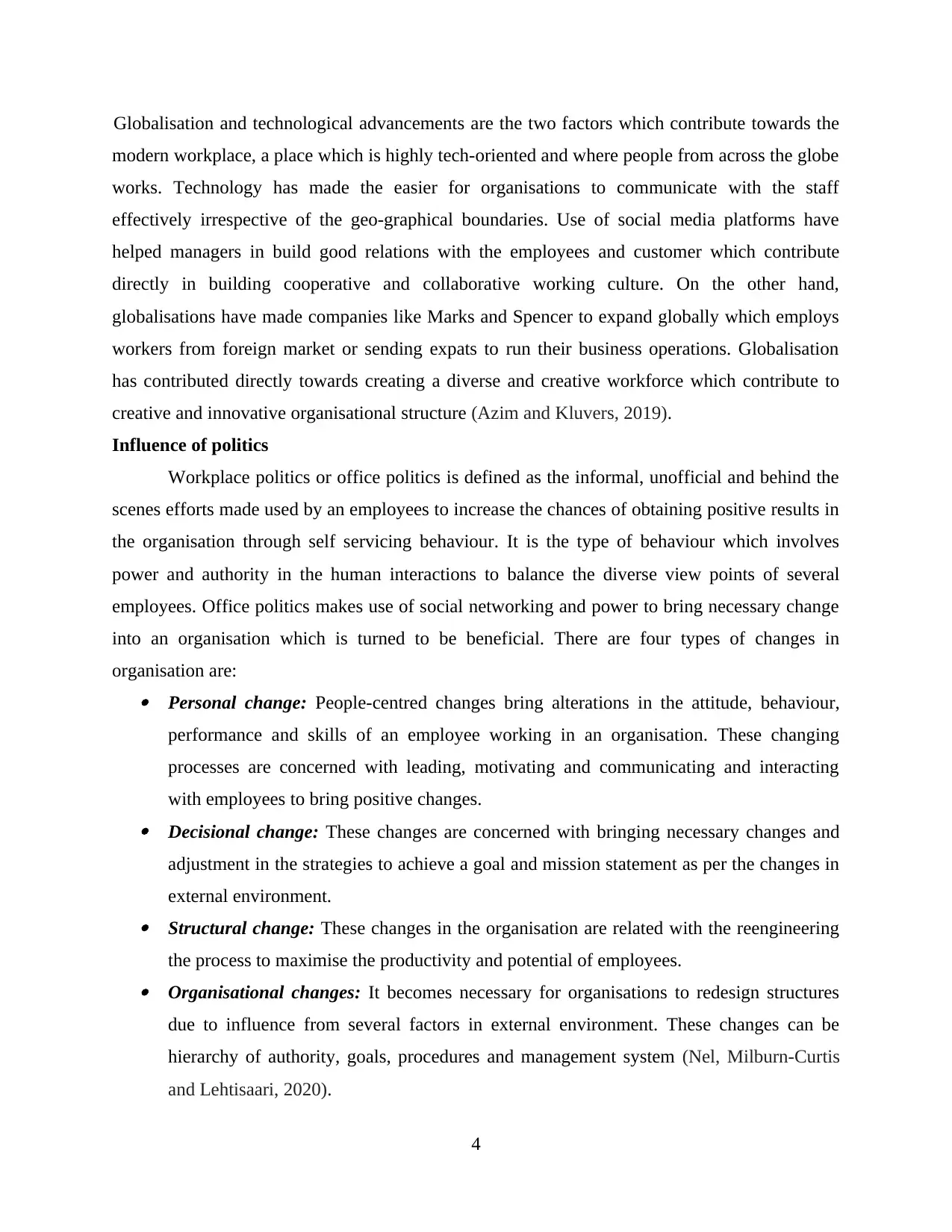
Globalisation and technological advancements are the two factors which contribute towards the
modern workplace, a place which is highly tech-oriented and where people from across the globe
works. Technology has made the easier for organisations to communicate with the staff
effectively irrespective of the geo-graphical boundaries. Use of social media platforms have
helped managers in build good relations with the employees and customer which contribute
directly in building cooperative and collaborative working culture. On the other hand,
globalisations have made companies like Marks and Spencer to expand globally which employs
workers from foreign market or sending expats to run their business operations. Globalisation
has contributed directly towards creating a diverse and creative workforce which contribute to
creative and innovative organisational structure (Azim and Kluvers, 2019).
Influence of politics
Workplace politics or office politics is defined as the informal, unofficial and behind the
scenes efforts made used by an employees to increase the chances of obtaining positive results in
the organisation through self servicing behaviour. It is the type of behaviour which involves
power and authority in the human interactions to balance the diverse view points of several
employees. Office politics makes use of social networking and power to bring necessary change
into an organisation which is turned to be beneficial. There are four types of changes in
organisation are: Personal change: People-centred changes bring alterations in the attitude, behaviour,
performance and skills of an employee working in an organisation. These changing
processes are concerned with leading, motivating and communicating and interacting
with employees to bring positive changes. Decisional change: These changes are concerned with bringing necessary changes and
adjustment in the strategies to achieve a goal and mission statement as per the changes in
external environment. Structural change: These changes in the organisation are related with the reengineering
the process to maximise the productivity and potential of employees. Organisational changes: It becomes necessary for organisations to redesign structures
due to influence from several factors in external environment. These changes can be
hierarchy of authority, goals, procedures and management system (Nel, Milburn-Curtis
and Lehtisaari, 2020).
4
modern workplace, a place which is highly tech-oriented and where people from across the globe
works. Technology has made the easier for organisations to communicate with the staff
effectively irrespective of the geo-graphical boundaries. Use of social media platforms have
helped managers in build good relations with the employees and customer which contribute
directly in building cooperative and collaborative working culture. On the other hand,
globalisations have made companies like Marks and Spencer to expand globally which employs
workers from foreign market or sending expats to run their business operations. Globalisation
has contributed directly towards creating a diverse and creative workforce which contribute to
creative and innovative organisational structure (Azim and Kluvers, 2019).
Influence of politics
Workplace politics or office politics is defined as the informal, unofficial and behind the
scenes efforts made used by an employees to increase the chances of obtaining positive results in
the organisation through self servicing behaviour. It is the type of behaviour which involves
power and authority in the human interactions to balance the diverse view points of several
employees. Office politics makes use of social networking and power to bring necessary change
into an organisation which is turned to be beneficial. There are four types of changes in
organisation are: Personal change: People-centred changes bring alterations in the attitude, behaviour,
performance and skills of an employee working in an organisation. These changing
processes are concerned with leading, motivating and communicating and interacting
with employees to bring positive changes. Decisional change: These changes are concerned with bringing necessary changes and
adjustment in the strategies to achieve a goal and mission statement as per the changes in
external environment. Structural change: These changes in the organisation are related with the reengineering
the process to maximise the productivity and potential of employees. Organisational changes: It becomes necessary for organisations to redesign structures
due to influence from several factors in external environment. These changes can be
hierarchy of authority, goals, procedures and management system (Nel, Milburn-Curtis
and Lehtisaari, 2020).
4
⊘ This is a preview!⊘
Do you want full access?
Subscribe today to unlock all pages.

Trusted by 1+ million students worldwide
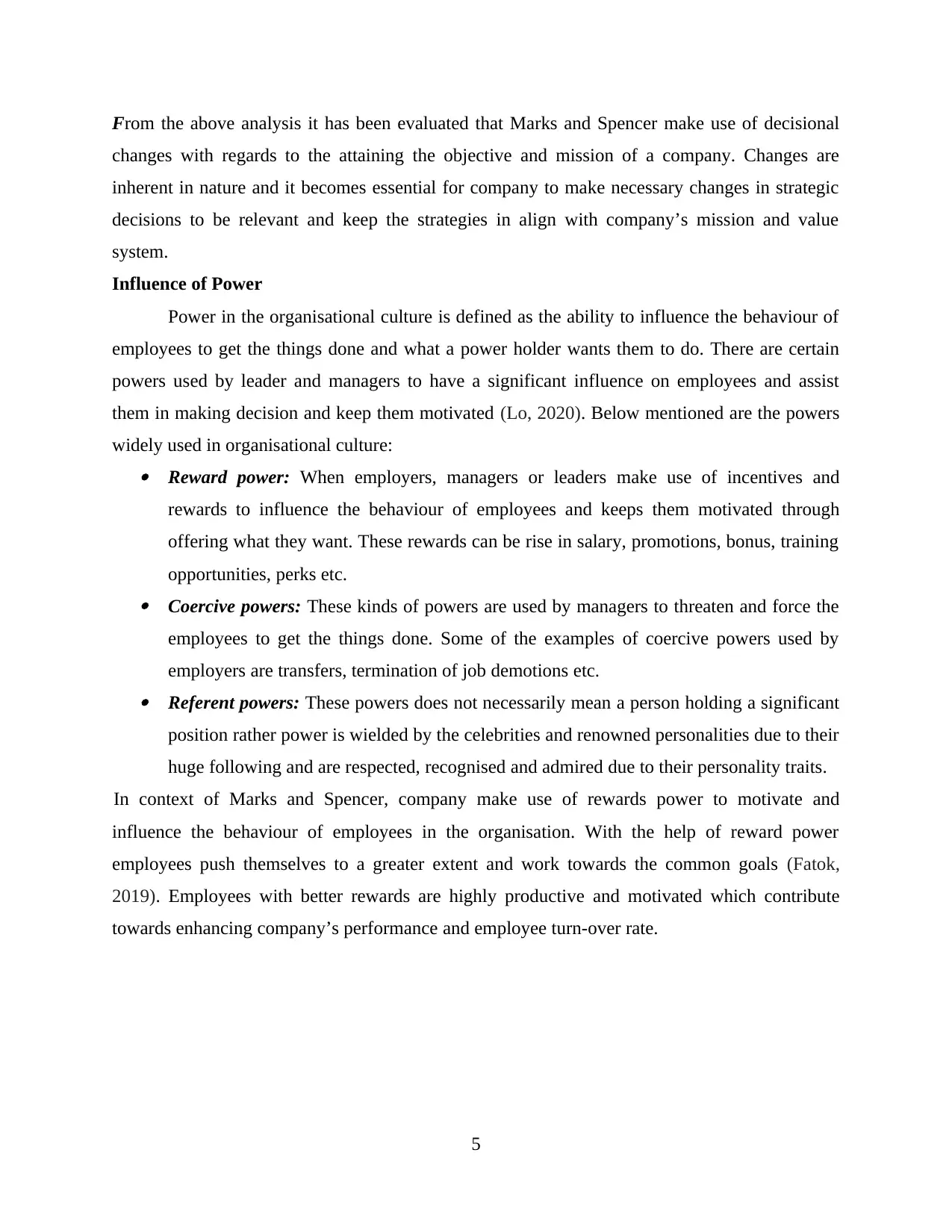
From the above analysis it has been evaluated that Marks and Spencer make use of decisional
changes with regards to the attaining the objective and mission of a company. Changes are
inherent in nature and it becomes essential for company to make necessary changes in strategic
decisions to be relevant and keep the strategies in align with company’s mission and value
system.
Influence of Power
Power in the organisational culture is defined as the ability to influence the behaviour of
employees to get the things done and what a power holder wants them to do. There are certain
powers used by leader and managers to have a significant influence on employees and assist
them in making decision and keep them motivated (Lo, 2020). Below mentioned are the powers
widely used in organisational culture: Reward power: When employers, managers or leaders make use of incentives and
rewards to influence the behaviour of employees and keeps them motivated through
offering what they want. These rewards can be rise in salary, promotions, bonus, training
opportunities, perks etc. Coercive powers: These kinds of powers are used by managers to threaten and force the
employees to get the things done. Some of the examples of coercive powers used by
employers are transfers, termination of job demotions etc. Referent powers: These powers does not necessarily mean a person holding a significant
position rather power is wielded by the celebrities and renowned personalities due to their
huge following and are respected, recognised and admired due to their personality traits.
In context of Marks and Spencer, company make use of rewards power to motivate and
influence the behaviour of employees in the organisation. With the help of reward power
employees push themselves to a greater extent and work towards the common goals (Fatok,
2019). Employees with better rewards are highly productive and motivated which contribute
towards enhancing company’s performance and employee turn-over rate.
5
changes with regards to the attaining the objective and mission of a company. Changes are
inherent in nature and it becomes essential for company to make necessary changes in strategic
decisions to be relevant and keep the strategies in align with company’s mission and value
system.
Influence of Power
Power in the organisational culture is defined as the ability to influence the behaviour of
employees to get the things done and what a power holder wants them to do. There are certain
powers used by leader and managers to have a significant influence on employees and assist
them in making decision and keep them motivated (Lo, 2020). Below mentioned are the powers
widely used in organisational culture: Reward power: When employers, managers or leaders make use of incentives and
rewards to influence the behaviour of employees and keeps them motivated through
offering what they want. These rewards can be rise in salary, promotions, bonus, training
opportunities, perks etc. Coercive powers: These kinds of powers are used by managers to threaten and force the
employees to get the things done. Some of the examples of coercive powers used by
employers are transfers, termination of job demotions etc. Referent powers: These powers does not necessarily mean a person holding a significant
position rather power is wielded by the celebrities and renowned personalities due to their
huge following and are respected, recognised and admired due to their personality traits.
In context of Marks and Spencer, company make use of rewards power to motivate and
influence the behaviour of employees in the organisation. With the help of reward power
employees push themselves to a greater extent and work towards the common goals (Fatok,
2019). Employees with better rewards are highly productive and motivated which contribute
towards enhancing company’s performance and employee turn-over rate.
5
Paraphrase This Document
Need a fresh take? Get an instant paraphrase of this document with our AI Paraphraser
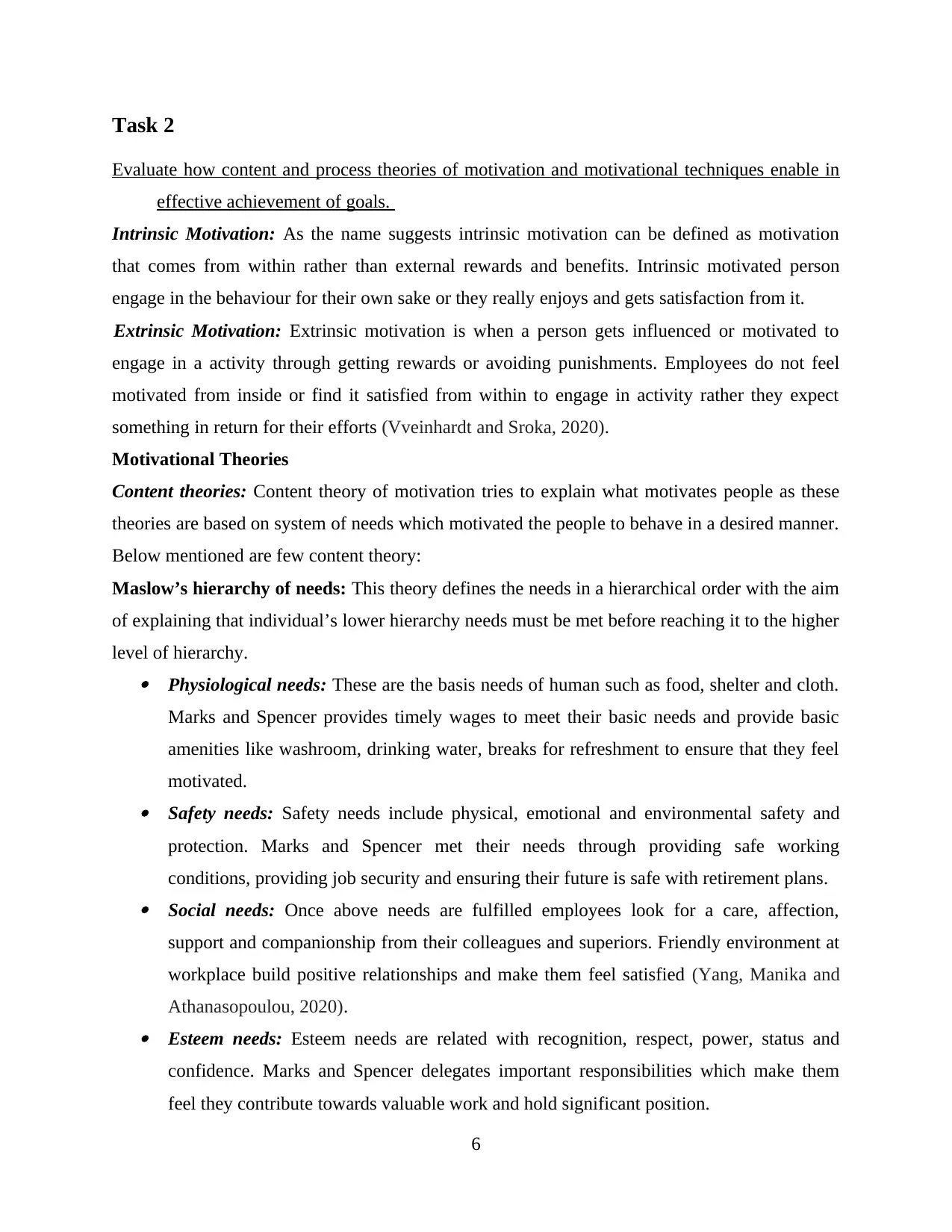
Task 2
Evaluate how content and process theories of motivation and motivational techniques enable in
effective achievement of goals.
Intrinsic Motivation: As the name suggests intrinsic motivation can be defined as motivation
that comes from within rather than external rewards and benefits. Intrinsic motivated person
engage in the behaviour for their own sake or they really enjoys and gets satisfaction from it.
Extrinsic Motivation: Extrinsic motivation is when a person gets influenced or motivated to
engage in a activity through getting rewards or avoiding punishments. Employees do not feel
motivated from inside or find it satisfied from within to engage in activity rather they expect
something in return for their efforts (Vveinhardt and Sroka, 2020).
Motivational Theories
Content theories: Content theory of motivation tries to explain what motivates people as these
theories are based on system of needs which motivated the people to behave in a desired manner.
Below mentioned are few content theory:
Maslow’s hierarchy of needs: This theory defines the needs in a hierarchical order with the aim
of explaining that individual’s lower hierarchy needs must be met before reaching it to the higher
level of hierarchy. Physiological needs: These are the basis needs of human such as food, shelter and cloth.
Marks and Spencer provides timely wages to meet their basic needs and provide basic
amenities like washroom, drinking water, breaks for refreshment to ensure that they feel
motivated. Safety needs: Safety needs include physical, emotional and environmental safety and
protection. Marks and Spencer met their needs through providing safe working
conditions, providing job security and ensuring their future is safe with retirement plans. Social needs: Once above needs are fulfilled employees look for a care, affection,
support and companionship from their colleagues and superiors. Friendly environment at
workplace build positive relationships and make them feel satisfied (Yang, Manika and
Athanasopoulou, 2020). Esteem needs: Esteem needs are related with recognition, respect, power, status and
confidence. Marks and Spencer delegates important responsibilities which make them
feel they contribute towards valuable work and hold significant position.
6
Evaluate how content and process theories of motivation and motivational techniques enable in
effective achievement of goals.
Intrinsic Motivation: As the name suggests intrinsic motivation can be defined as motivation
that comes from within rather than external rewards and benefits. Intrinsic motivated person
engage in the behaviour for their own sake or they really enjoys and gets satisfaction from it.
Extrinsic Motivation: Extrinsic motivation is when a person gets influenced or motivated to
engage in a activity through getting rewards or avoiding punishments. Employees do not feel
motivated from inside or find it satisfied from within to engage in activity rather they expect
something in return for their efforts (Vveinhardt and Sroka, 2020).
Motivational Theories
Content theories: Content theory of motivation tries to explain what motivates people as these
theories are based on system of needs which motivated the people to behave in a desired manner.
Below mentioned are few content theory:
Maslow’s hierarchy of needs: This theory defines the needs in a hierarchical order with the aim
of explaining that individual’s lower hierarchy needs must be met before reaching it to the higher
level of hierarchy. Physiological needs: These are the basis needs of human such as food, shelter and cloth.
Marks and Spencer provides timely wages to meet their basic needs and provide basic
amenities like washroom, drinking water, breaks for refreshment to ensure that they feel
motivated. Safety needs: Safety needs include physical, emotional and environmental safety and
protection. Marks and Spencer met their needs through providing safe working
conditions, providing job security and ensuring their future is safe with retirement plans. Social needs: Once above needs are fulfilled employees look for a care, affection,
support and companionship from their colleagues and superiors. Friendly environment at
workplace build positive relationships and make them feel satisfied (Yang, Manika and
Athanasopoulou, 2020). Esteem needs: Esteem needs are related with recognition, respect, power, status and
confidence. Marks and Spencer delegates important responsibilities which make them
feel they contribute towards valuable work and hold significant position.
6
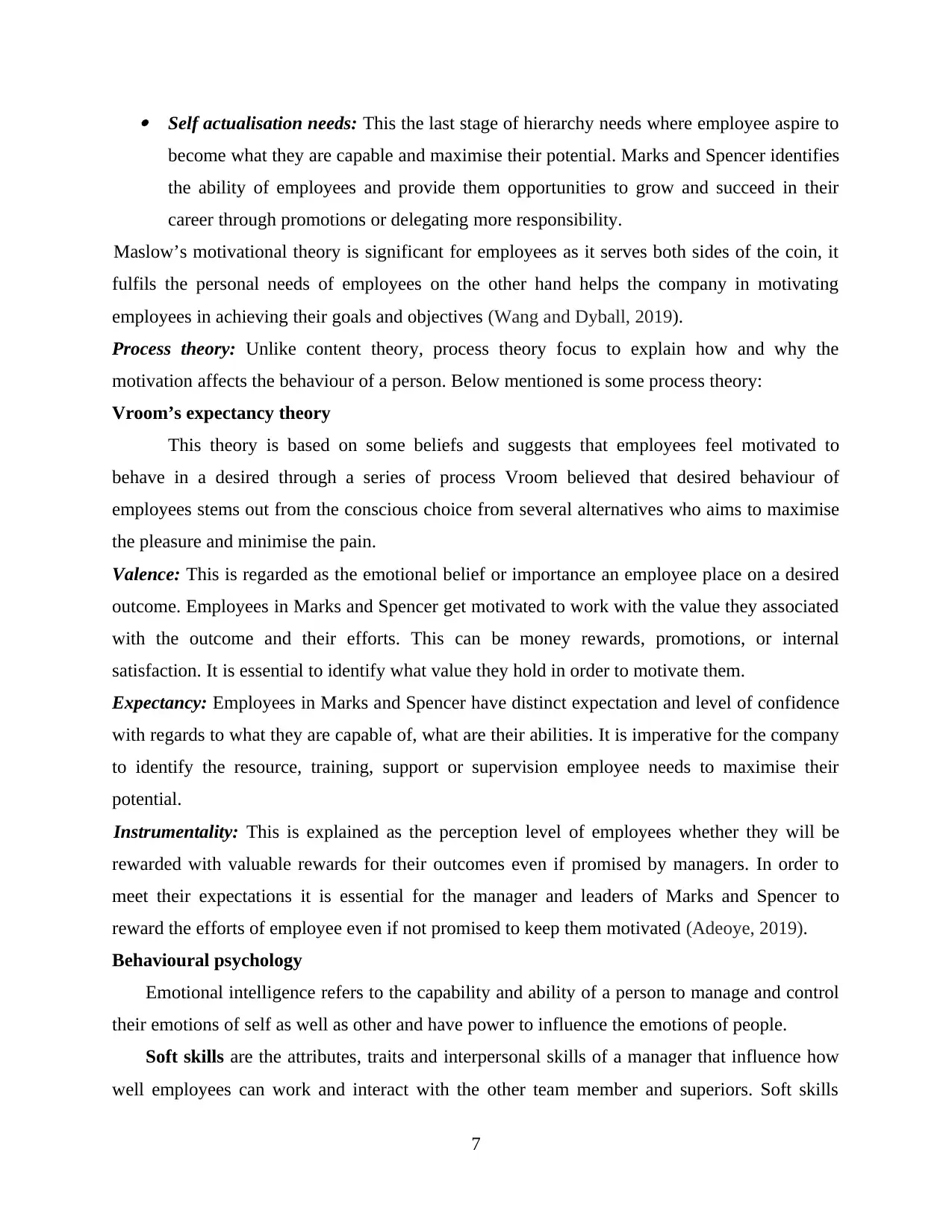
Self actualisation needs: This the last stage of hierarchy needs where employee aspire to
become what they are capable and maximise their potential. Marks and Spencer identifies
the ability of employees and provide them opportunities to grow and succeed in their
career through promotions or delegating more responsibility.
Maslow’s motivational theory is significant for employees as it serves both sides of the coin, it
fulfils the personal needs of employees on the other hand helps the company in motivating
employees in achieving their goals and objectives (Wang and Dyball, 2019).
Process theory: Unlike content theory, process theory focus to explain how and why the
motivation affects the behaviour of a person. Below mentioned is some process theory:
Vroom’s expectancy theory
This theory is based on some beliefs and suggests that employees feel motivated to
behave in a desired through a series of process Vroom believed that desired behaviour of
employees stems out from the conscious choice from several alternatives who aims to maximise
the pleasure and minimise the pain.
Valence: This is regarded as the emotional belief or importance an employee place on a desired
outcome. Employees in Marks and Spencer get motivated to work with the value they associated
with the outcome and their efforts. This can be money rewards, promotions, or internal
satisfaction. It is essential to identify what value they hold in order to motivate them.
Expectancy: Employees in Marks and Spencer have distinct expectation and level of confidence
with regards to what they are capable of, what are their abilities. It is imperative for the company
to identify the resource, training, support or supervision employee needs to maximise their
potential.
Instrumentality: This is explained as the perception level of employees whether they will be
rewarded with valuable rewards for their outcomes even if promised by managers. In order to
meet their expectations it is essential for the manager and leaders of Marks and Spencer to
reward the efforts of employee even if not promised to keep them motivated (Adeoye, 2019).
Behavioural psychology
Emotional intelligence refers to the capability and ability of a person to manage and control
their emotions of self as well as other and have power to influence the emotions of people.
Soft skills are the attributes, traits and interpersonal skills of a manager that influence how
well employees can work and interact with the other team member and superiors. Soft skills
7
become what they are capable and maximise their potential. Marks and Spencer identifies
the ability of employees and provide them opportunities to grow and succeed in their
career through promotions or delegating more responsibility.
Maslow’s motivational theory is significant for employees as it serves both sides of the coin, it
fulfils the personal needs of employees on the other hand helps the company in motivating
employees in achieving their goals and objectives (Wang and Dyball, 2019).
Process theory: Unlike content theory, process theory focus to explain how and why the
motivation affects the behaviour of a person. Below mentioned is some process theory:
Vroom’s expectancy theory
This theory is based on some beliefs and suggests that employees feel motivated to
behave in a desired through a series of process Vroom believed that desired behaviour of
employees stems out from the conscious choice from several alternatives who aims to maximise
the pleasure and minimise the pain.
Valence: This is regarded as the emotional belief or importance an employee place on a desired
outcome. Employees in Marks and Spencer get motivated to work with the value they associated
with the outcome and their efforts. This can be money rewards, promotions, or internal
satisfaction. It is essential to identify what value they hold in order to motivate them.
Expectancy: Employees in Marks and Spencer have distinct expectation and level of confidence
with regards to what they are capable of, what are their abilities. It is imperative for the company
to identify the resource, training, support or supervision employee needs to maximise their
potential.
Instrumentality: This is explained as the perception level of employees whether they will be
rewarded with valuable rewards for their outcomes even if promised by managers. In order to
meet their expectations it is essential for the manager and leaders of Marks and Spencer to
reward the efforts of employee even if not promised to keep them motivated (Adeoye, 2019).
Behavioural psychology
Emotional intelligence refers to the capability and ability of a person to manage and control
their emotions of self as well as other and have power to influence the emotions of people.
Soft skills are the attributes, traits and interpersonal skills of a manager that influence how
well employees can work and interact with the other team member and superiors. Soft skills
7
⊘ This is a preview!⊘
Do you want full access?
Subscribe today to unlock all pages.

Trusted by 1+ million students worldwide
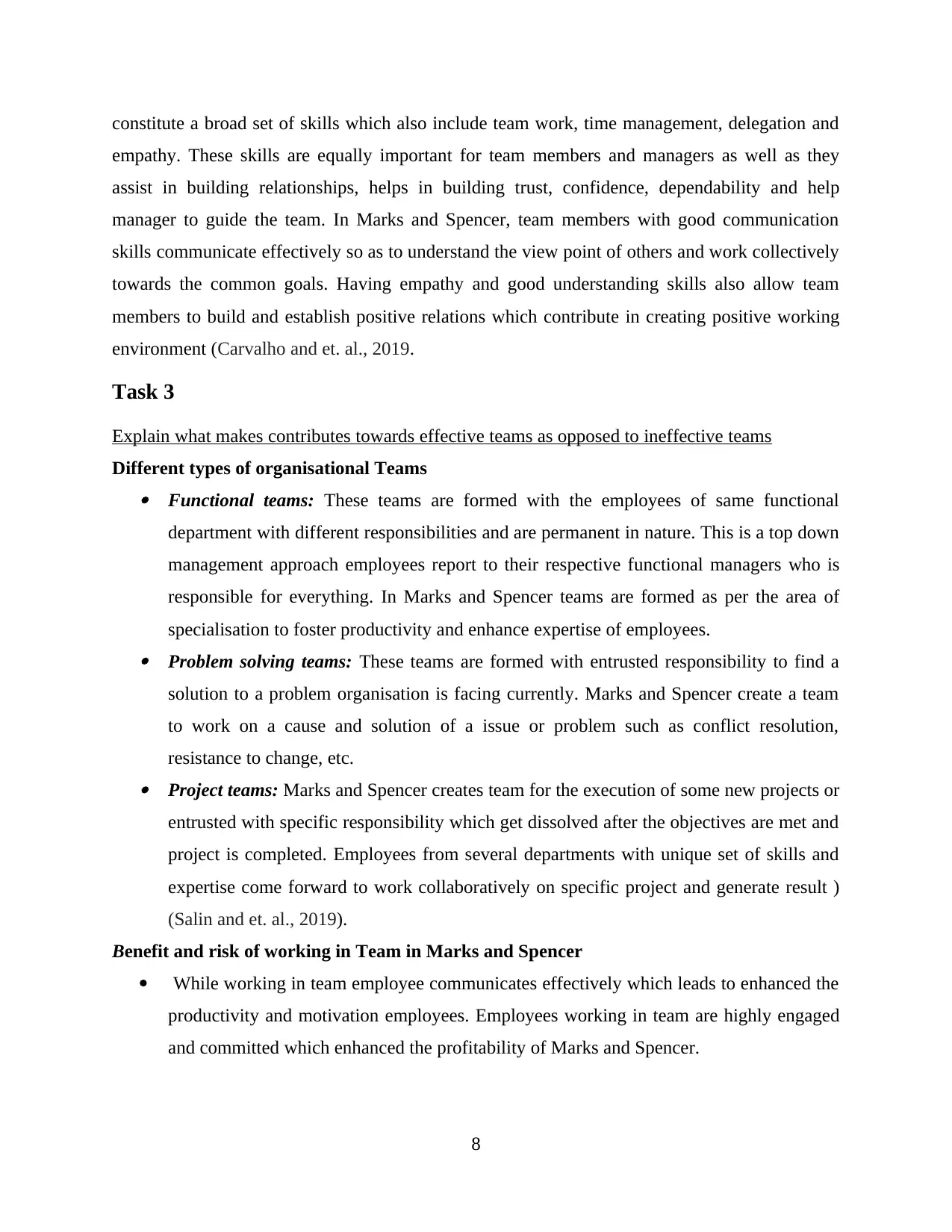
constitute a broad set of skills which also include team work, time management, delegation and
empathy. These skills are equally important for team members and managers as well as they
assist in building relationships, helps in building trust, confidence, dependability and help
manager to guide the team. In Marks and Spencer, team members with good communication
skills communicate effectively so as to understand the view point of others and work collectively
towards the common goals. Having empathy and good understanding skills also allow team
members to build and establish positive relations which contribute in creating positive working
environment (Carvalho and et. al., 2019.
Task 3
Explain what makes contributes towards effective teams as opposed to ineffective teams
Different types of organisational Teams Functional teams: These teams are formed with the employees of same functional
department with different responsibilities and are permanent in nature. This is a top down
management approach employees report to their respective functional managers who is
responsible for everything. In Marks and Spencer teams are formed as per the area of
specialisation to foster productivity and enhance expertise of employees. Problem solving teams: These teams are formed with entrusted responsibility to find a
solution to a problem organisation is facing currently. Marks and Spencer create a team
to work on a cause and solution of a issue or problem such as conflict resolution,
resistance to change, etc. Project teams: Marks and Spencer creates team for the execution of some new projects or
entrusted with specific responsibility which get dissolved after the objectives are met and
project is completed. Employees from several departments with unique set of skills and
expertise come forward to work collaboratively on specific project and generate result )
(Salin and et. al., 2019).
Benefit and risk of working in Team in Marks and Spencer
While working in team employee communicates effectively which leads to enhanced the
productivity and motivation employees. Employees working in team are highly engaged
and committed which enhanced the profitability of Marks and Spencer.
8
empathy. These skills are equally important for team members and managers as well as they
assist in building relationships, helps in building trust, confidence, dependability and help
manager to guide the team. In Marks and Spencer, team members with good communication
skills communicate effectively so as to understand the view point of others and work collectively
towards the common goals. Having empathy and good understanding skills also allow team
members to build and establish positive relations which contribute in creating positive working
environment (Carvalho and et. al., 2019.
Task 3
Explain what makes contributes towards effective teams as opposed to ineffective teams
Different types of organisational Teams Functional teams: These teams are formed with the employees of same functional
department with different responsibilities and are permanent in nature. This is a top down
management approach employees report to their respective functional managers who is
responsible for everything. In Marks and Spencer teams are formed as per the area of
specialisation to foster productivity and enhance expertise of employees. Problem solving teams: These teams are formed with entrusted responsibility to find a
solution to a problem organisation is facing currently. Marks and Spencer create a team
to work on a cause and solution of a issue or problem such as conflict resolution,
resistance to change, etc. Project teams: Marks and Spencer creates team for the execution of some new projects or
entrusted with specific responsibility which get dissolved after the objectives are met and
project is completed. Employees from several departments with unique set of skills and
expertise come forward to work collaboratively on specific project and generate result )
(Salin and et. al., 2019).
Benefit and risk of working in Team in Marks and Spencer
While working in team employee communicates effectively which leads to enhanced the
productivity and motivation employees. Employees working in team are highly engaged
and committed which enhanced the profitability of Marks and Spencer.
8
Paraphrase This Document
Need a fresh take? Get an instant paraphrase of this document with our AI Paraphraser
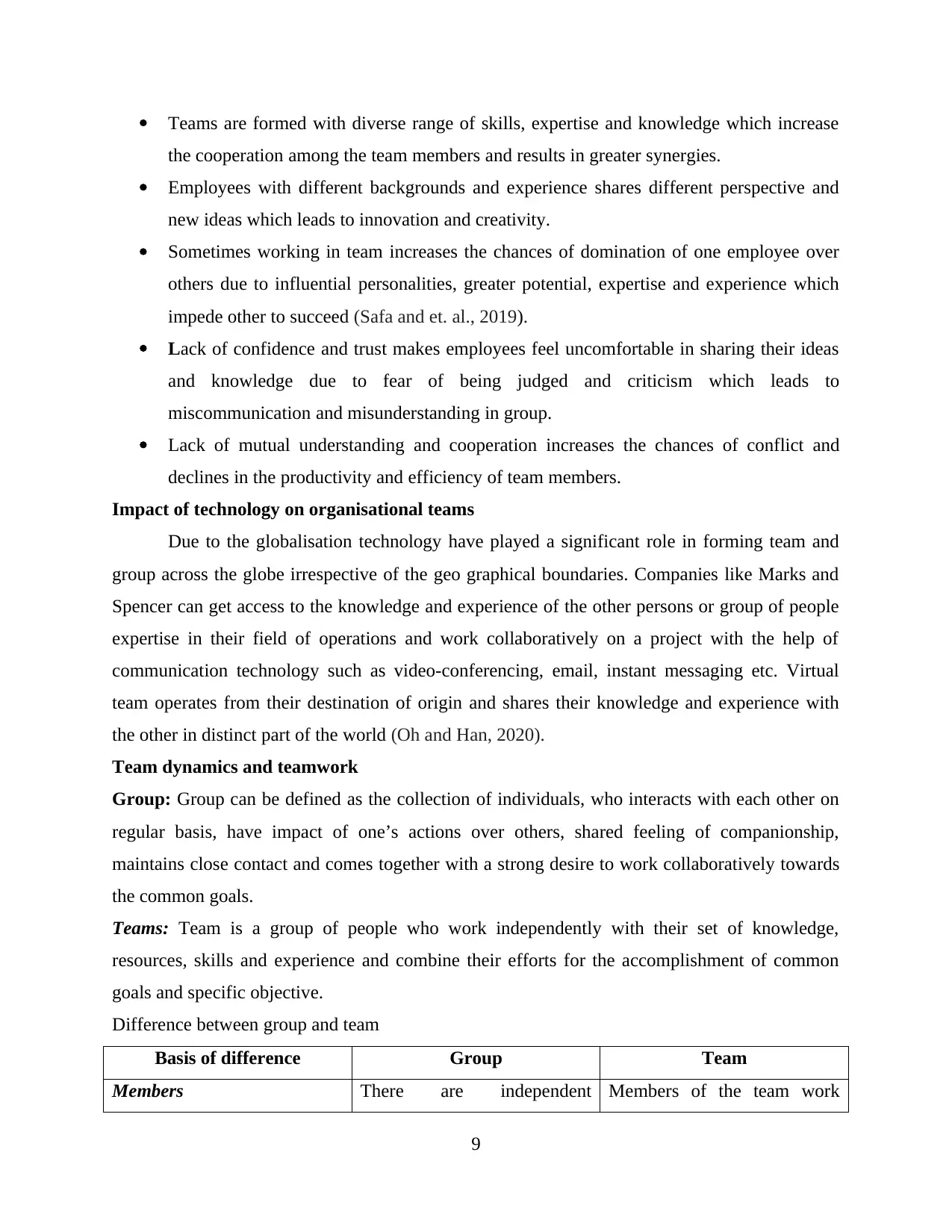
Teams are formed with diverse range of skills, expertise and knowledge which increase
the cooperation among the team members and results in greater synergies.
Employees with different backgrounds and experience shares different perspective and
new ideas which leads to innovation and creativity.
Sometimes working in team increases the chances of domination of one employee over
others due to influential personalities, greater potential, expertise and experience which
impede other to succeed (Safa and et. al., 2019).
Lack of confidence and trust makes employees feel uncomfortable in sharing their ideas
and knowledge due to fear of being judged and criticism which leads to
miscommunication and misunderstanding in group.
Lack of mutual understanding and cooperation increases the chances of conflict and
declines in the productivity and efficiency of team members.
Impact of technology on organisational teams
Due to the globalisation technology have played a significant role in forming team and
group across the globe irrespective of the geo graphical boundaries. Companies like Marks and
Spencer can get access to the knowledge and experience of the other persons or group of people
expertise in their field of operations and work collaboratively on a project with the help of
communication technology such as video-conferencing, email, instant messaging etc. Virtual
team operates from their destination of origin and shares their knowledge and experience with
the other in distinct part of the world (Oh and Han, 2020).
Team dynamics and teamwork
Group: Group can be defined as the collection of individuals, who interacts with each other on
regular basis, have impact of one’s actions over others, shared feeling of companionship,
maintains close contact and comes together with a strong desire to work collaboratively towards
the common goals.
Teams: Team is a group of people who work independently with their set of knowledge,
resources, skills and experience and combine their efforts for the accomplishment of common
goals and specific objective.
Difference between group and team
Basis of difference Group Team
Members There are independent Members of the team work
9
the cooperation among the team members and results in greater synergies.
Employees with different backgrounds and experience shares different perspective and
new ideas which leads to innovation and creativity.
Sometimes working in team increases the chances of domination of one employee over
others due to influential personalities, greater potential, expertise and experience which
impede other to succeed (Safa and et. al., 2019).
Lack of confidence and trust makes employees feel uncomfortable in sharing their ideas
and knowledge due to fear of being judged and criticism which leads to
miscommunication and misunderstanding in group.
Lack of mutual understanding and cooperation increases the chances of conflict and
declines in the productivity and efficiency of team members.
Impact of technology on organisational teams
Due to the globalisation technology have played a significant role in forming team and
group across the globe irrespective of the geo graphical boundaries. Companies like Marks and
Spencer can get access to the knowledge and experience of the other persons or group of people
expertise in their field of operations and work collaboratively on a project with the help of
communication technology such as video-conferencing, email, instant messaging etc. Virtual
team operates from their destination of origin and shares their knowledge and experience with
the other in distinct part of the world (Oh and Han, 2020).
Team dynamics and teamwork
Group: Group can be defined as the collection of individuals, who interacts with each other on
regular basis, have impact of one’s actions over others, shared feeling of companionship,
maintains close contact and comes together with a strong desire to work collaboratively towards
the common goals.
Teams: Team is a group of people who work independently with their set of knowledge,
resources, skills and experience and combine their efforts for the accomplishment of common
goals and specific objective.
Difference between group and team
Basis of difference Group Team
Members There are independent Members of the team work
9
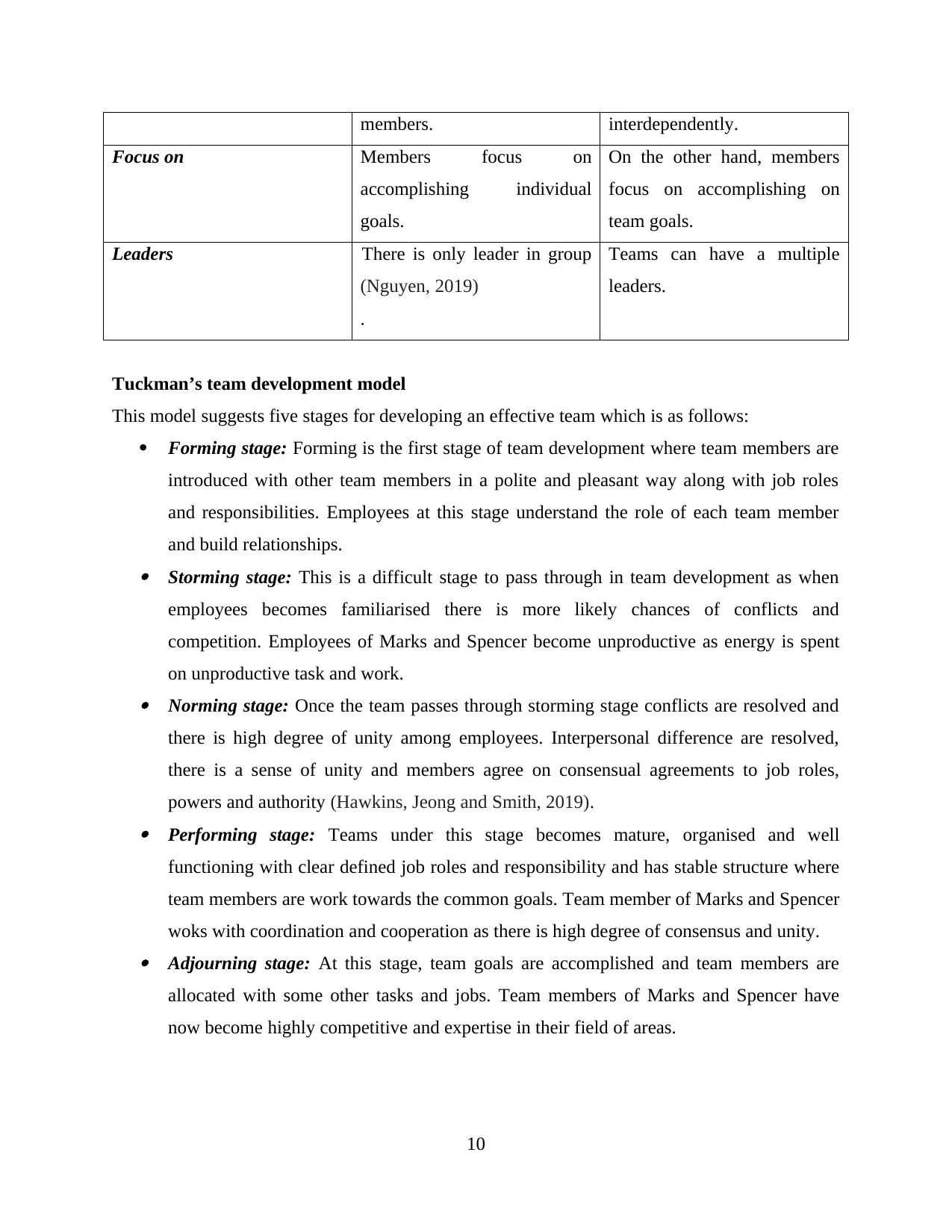
members. interdependently.
Focus on Members focus on
accomplishing individual
goals.
On the other hand, members
focus on accomplishing on
team goals.
Leaders There is only leader in group
(Nguyen, 2019)
.
Teams can have a multiple
leaders.
Tuckman’s team development model
This model suggests five stages for developing an effective team which is as follows:
Forming stage: Forming is the first stage of team development where team members are
introduced with other team members in a polite and pleasant way along with job roles
and responsibilities. Employees at this stage understand the role of each team member
and build relationships. Storming stage: This is a difficult stage to pass through in team development as when
employees becomes familiarised there is more likely chances of conflicts and
competition. Employees of Marks and Spencer become unproductive as energy is spent
on unproductive task and work. Norming stage: Once the team passes through storming stage conflicts are resolved and
there is high degree of unity among employees. Interpersonal difference are resolved,
there is a sense of unity and members agree on consensual agreements to job roles,
powers and authority (Hawkins, Jeong and Smith, 2019). Performing stage: Teams under this stage becomes mature, organised and well
functioning with clear defined job roles and responsibility and has stable structure where
team members are work towards the common goals. Team member of Marks and Spencer
woks with coordination and cooperation as there is high degree of consensus and unity. Adjourning stage: At this stage, team goals are accomplished and team members are
allocated with some other tasks and jobs. Team members of Marks and Spencer have
now become highly competitive and expertise in their field of areas.
10
Focus on Members focus on
accomplishing individual
goals.
On the other hand, members
focus on accomplishing on
team goals.
Leaders There is only leader in group
(Nguyen, 2019)
.
Teams can have a multiple
leaders.
Tuckman’s team development model
This model suggests five stages for developing an effective team which is as follows:
Forming stage: Forming is the first stage of team development where team members are
introduced with other team members in a polite and pleasant way along with job roles
and responsibilities. Employees at this stage understand the role of each team member
and build relationships. Storming stage: This is a difficult stage to pass through in team development as when
employees becomes familiarised there is more likely chances of conflicts and
competition. Employees of Marks and Spencer become unproductive as energy is spent
on unproductive task and work. Norming stage: Once the team passes through storming stage conflicts are resolved and
there is high degree of unity among employees. Interpersonal difference are resolved,
there is a sense of unity and members agree on consensual agreements to job roles,
powers and authority (Hawkins, Jeong and Smith, 2019). Performing stage: Teams under this stage becomes mature, organised and well
functioning with clear defined job roles and responsibility and has stable structure where
team members are work towards the common goals. Team member of Marks and Spencer
woks with coordination and cooperation as there is high degree of consensus and unity. Adjourning stage: At this stage, team goals are accomplished and team members are
allocated with some other tasks and jobs. Team members of Marks and Spencer have
now become highly competitive and expertise in their field of areas.
10
⊘ This is a preview!⊘
Do you want full access?
Subscribe today to unlock all pages.

Trusted by 1+ million students worldwide
1 out of 18
Related Documents
Your All-in-One AI-Powered Toolkit for Academic Success.
+13062052269
info@desklib.com
Available 24*7 on WhatsApp / Email
![[object Object]](/_next/static/media/star-bottom.7253800d.svg)
Unlock your academic potential
Copyright © 2020–2025 A2Z Services. All Rights Reserved. Developed and managed by ZUCOL.




